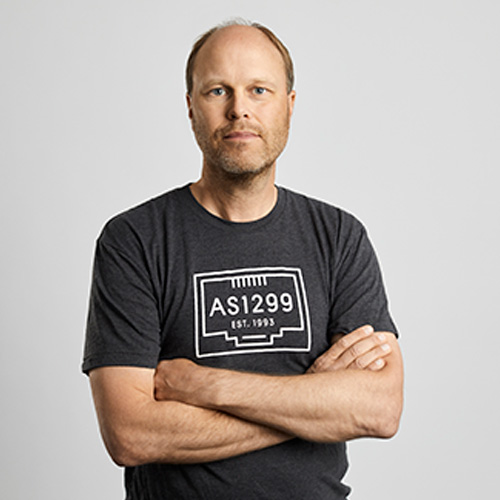As every corner of the globe is encouraged to increase their use of renewables, Mattias Fridström, Vice President and Chief Evangelist, Arelion, provides six considerations for network operators to help fast-track a greener future and ease the appetite of hungry data centres.

According to the United Nations, fossil fuels, including coal, oil and gas, currently account for over 75% of global greenhouse gas emissions and nearly 90% of all carbon dioxide emissions. In addition, it observes that fossil fuels still account for more than 80% of global energy production, with only about 29% of electricity currently coming from renewable sources.
The UN states that the science is clear. To avoid the worst impacts of climate change, emissions need to be reduced by almost half by 2030 and reach net zero by 2050. To achieve this, we need to end our reliance on fossil fuels and invest in alternative sources of energy that are clean, accessible, affordable, sustainable and reliable.
As if this challenge were not enough, Russia’s invasion of Ukraine has added an energy crisis into the mix. As the Institute of Economic Affairs (IEA) highlights in its World Energy Outlook 2022, ‘Today’s energy shock is a reminder of the fragility and unsustainability of our current energy system. A key question for policy makers is whether the crisis will be a setback for clean energy transitions or will catalyse faster action.’
The IEA’s analysis – at least in the longer term – is optimistic. It says that government responses to the crisis in major markets are ‘fast-tracking the emergence of a clean energy economy’. It calculates that policies around the world will help propel annual clean energy investment to more than US$2 trillion by 2030, a rise on current spending of more than 50%. It predicts that as markets rebalance, renewables, supported by nuclear power, will see sustained gains, with the recent upside for coal from today’s crisis being short-lived.
The IEA concludes: ‘The world is in a critical decade for delivering a more secure, sustainable and affordable energy system – the potential for faster progress is enormous if strong action is taken immediately.’
Powering the Internet
Focusing specifically on energy and the Internet, the net is clearly highly energy intensive. According to KTH Royal Institute of Technology in Sweden, about 9% of the world’s total electricity consumption is currently used by the Internet, and this figure is set to double by 2025.
Data centres are particularly energy hungry, with a large facility typically using more than 30 GWh per year. Such heavy consumption makes it unsurprising that efforts have so far been focused on how to increase the energy efficiency of data centres and reduce their carbon footprint.
Measures include locating centres in the most energy efficient locations, such as Meta’s Lulea data centre near the Arctic Circle in Sweden, which uses outside air for cooling and runs on hydroelectric power. Meta, along with some of the world’s largest data centre users, including Apple, Google and Microsoft, have also committed to using 100% renewable energy.
Despite such positive moves, the data centre sector has much further to go, with critics pointing out that currently only about 20% of the electricity they use is from renewables. For example, a 2020 study by Arelion (then Telia Carrier) demonstrated that data centre relocation to Sweden, and Stockholm in particular, presents a compelling and sustainable opportunity for an energy-intensive industry to source cheap electricity with a low carbon footprint, while operating within acceptable latency limits.
In search of sustainable networks
In 2023, Arelion published a research report about the impact of the energy crisis on business networks in several key segments – including IT, financial services and banking, pharmaceuticals and manufacturing – which revealed that 40% see solar energy as the power source of choice for the networks of the future. However, this view seems unrealistic due to the intermittent nature of solar energy production.
Successful network operations depend entirely upon a reliable and consistent source of energy 24/7. Even with the right infrastructure in place, the sun simply does not shine for long enough, or predictably enough, in many areas of the world. Until we see a paradigm shift in battery technology, solar and wind power are essentially just complementary power sources that serve to reduce the costs and carbon footprint of a network.
Despite this, I believe that network operators have a crucial role to play in promoting sustainable energy resources and maximising network energy efficiency. Consumption needs to be reduced in our sector, especially considering the current cost of energy. As an industry, we are great at installing new, more efficient hardware, but constantly adding hardware is only part of the story. In telecoms, we need to get better at unplugging. Through better planning, inventory management and preventative maintenance, huge progress can be made on improving energy efficiency of active infrastructure as well as replacing and decommissioning older equipment.
Key steps to sustainability
As an industry, it is fair to say that for the time being at least, solar power – and indeed non-nuclear and non-fossil-based energy sources – cannot power the Internet alone, and while network operators may not be able to solve the green energy shortfall, there are some key measures they should consider:
- Monitor and maximise operational energy efficiency measures
- Decommission older power-hungry equipment
- Seek innovative solutions that improve network efficiency, while cutting power consumption and costs
- Maximise use of green energy such as solar and wind power
- Audit data centres in relation to energy efficiency
- Consider the sustainability strategy of third parties in the supply chain
The message from experts at organisations such as the UN and IEA, among others, is clear: households and businesses should strive for energy efficiency and increase their use of renewables wherever possible. Network operators are no exception.
Click below to share this article


